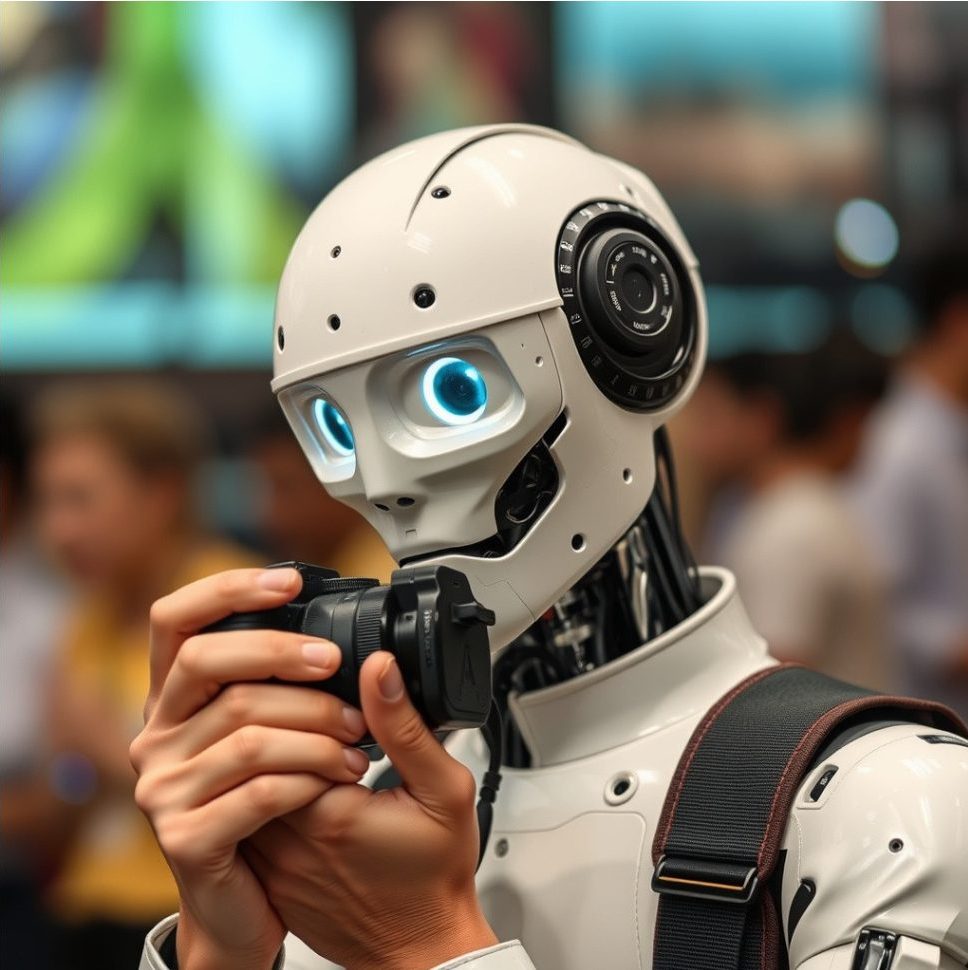Lights, Camera AI. Dive into the AI behind the Lens.
Artificial Intelligence (AI) is revolutionizing virtually every industry, and the world of photography and videography is no exception. While creativity and artistic vision have traditionally been the hallmarks of photographers and videographers, AI is emerging as a powerful tool that enhances, streamlines, and sometimes even automates many aspects of visual production. From automated editing to smarter cameras and intelligent content management, AI is reshaping the workflow, making it easier to produce high-quality content. In this essay, we’ll explore the role of AI in modern photography and videography and how it’s transforming the way creators work.
Modern cameras are becoming smarter with the integration of AI, enabling users to capture better photos and videos effortlessly. Many smartphones and digital cameras now come equipped with AI-powered features such as scene recognition, real-time tracking, and even mood detection. For instance, when you point your smartphone camera at a landscape, the AI can recognize the scene, adjust settings for optimal lighting, and even apply a preset color filter to enhance the greenery or sky hues.
AI is also making cameras more intuitive with features like autofocus and subject tracking. Advanced algorithms use facial and object recognition to keep subjects in focus, even if they move around. This technology is especially useful in dynamic settings like sports or wildlife photography. Cameras like the Sony A7R IV use real-time eye-tracking to ensure portraits remain sharp, while other cameras can track multiple objects in a single frame.
For videographers, AI-driven stabilization has become a game-changer. In-camera stabilization systems use machine learning to predict and correct for movement, reducing the need for bulky tripods or expensive gimbals. This results in smoother handheld shots, even when shooting action-packed sequences. Moreover, AI’s role in drone photography has expanded, enabling features like object detection and collision avoidance, which allow drones to navigate complex environments autonomously.
Once the footage is captured, AI continues to assist creators in the post-production process. Traditional editing can be time-consuming and labor-intensive, but AI-powered software has streamlined these workflows significantly. AI tools like Adobe Sensei and Luminar AI can automatically analyze an image or video and apply adjustments that would typically take hours of manual editing.
In photography, AI assists with everything from exposure correction to retouching. For example, AI-based software can enhance skies, detect and remove blemishes, and even change the time of day in a photo. Programs like Skylum’s Luminar AI offer one-click enhancements that analyze various elements in an image, such as faces, objects, and backgrounds, to make selective adjustments. Photographers can now achieve professional results in a fraction of the time, allowing them to focus more on creativity than technicalities.
AI’s role in masking and background replacement is another innovation. Using AI, photographers can now separate subjects from backgrounds with pixel-level precision, a task that would otherwise require hours of manual masking. This has opened up new possibilities for compositing, making it easier to create surreal or hyper-realistic images.
For videographers, AI can automate tedious tasks like cutting clips, applying transitions, and even color grading. Tools like Adobe Premiere Pro’s Auto Reframe can analyze a video and automatically adjust the framing for different aspect ratios, making it easier to repurpose content for platforms like Instagram or YouTube. Similarly, AI-powered software like Runway ML can identify and isolate subjects in a video, enabling editors to change backgrounds or apply effects without a green screen.
One of the most exciting developments in AI video editing is deep learning algorithms that can automate scene detection and recommend cuts. This technology is becoming invaluable for documentary and wedding videographers, where hours of footage must be condensed into a compelling narrative. AI can sift through hundreds of hours of footage, highlight key moments, and even suggest the most emotionally impactful segments, drastically reducing editing time.
While AI is often seen as a tool for efficiency, it’s also enabling new forms of artistic expression in photography and videography. With Generative Adversarial Networks (GANs) and neural networks, AI can create entirely new content based on existing data. Photographers and videographers can use these technologies to explore styles, generate realistic textures, or even create surreal imagery that would be difficult to achieve with traditional techniques.
For instance, AI-powered style transfer can transform a simple photograph or video into a piece of art resembling the work of Van Gogh or Monet. Applications like DeepArt or Prisma use neural networks to analyze the artistic style of a famous painting and then apply it to a photograph, creating stunning visuals that blend the physical world with digital artistry.
Moreover, AI’s ability to generate synthetic images or videos is opening new doors for storytelling. Filmmakers can use AI to create photorealistic environments, de-age actors, or even resurrect long-dead artists. While this raises ethical questions about authenticity, it also presents an exciting opportunity to expand the boundaries of what’s possible in visual storytelling.
For photographers and videographers, managing thousands of media files can be overwhelming. AI is revolutionizing this process by making content organization more intuitive. Applications like Google Photos and Adobe Lightroom now use AI to tag and categorize images automatically based on their content. You can search for terms like “beach” or “sunset,” and the software will instantly find relevant images, even if they aren’t manually tagged.
AI also aids in facial recognition, enabling photographers to sort through portraits more easily. For event photographers, this means being able to find specific guests in a sea of images with just a few clicks. Similarly, for videographers working on large projects, AI can catalog footage based on scene detection, making it easier to retrieve specific clips during the editing process.
AI’s role in content management is not just about finding files but also about intelligent recommendations. AI systems can suggest which photos or videos might work best for specific projects based on visual composition, lighting, and even emotional impact. This can save creators significant time during the curation process, ensuring that only the best shots make it to the final edit.
Perhaps one of the most profound impacts of AI in photography and videography is its potential to democratize the medium. Advanced editing techniques that once required years of training are now accessible to beginners through intuitive AI-powered interfaces. This lowers the barrier to entry, enabling more people to experiment with visual storytelling.
For people with disabilities, AI is also making visual arts more accessible. Voice-controlled cameras and editing software allow those with limited mobility to capture and edit photos and videos independently. AI tools that can describe visual content also enable visually impaired users to participate in visual storytelling, broadening the scope of who can create and appreciate visual arts.
While AI brings numerous benefits to photography and videography, it also poses unique challenges. One of the primary concerns is the potential loss of creative control. As AI takes over more aspects of the creative process, some fear that artistic vision might be compromised or overshadowed by machine-generated aesthetics.
Moreover, the rise of deepfakes—videos altered using AI to realistically depict people saying or doing things they never did—raises ethical concerns. These manipulated videos can spread misinformation or damage reputations, highlighting the need for ethical guidelines in AI development.
Finally, AI’s reliance on massive amounts of data also poses privacy risks. For instance, facial recognition in cameras and editing software could be misused, leading to unauthorized surveillance or data breaches.
AI is rapidly transforming photography and videography, enhancing both the creative and technical aspects of the craft. From smarter shooting and automated editing to innovative content creation and accessible tools, AI is making it easier than ever to produce high-quality visual content. However, as we embrace these advancements, it’s crucial to navigate the ethical challenges they present and ensure that technology serves to augment, rather than replace, human creativity. As AI continues to evolve, it will undoubtedly reshape the visual arts, pushing the boundaries of what’s possible and redefining the role of the photographer and videographer in the digital age.


Leave a Reply